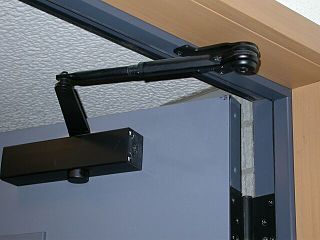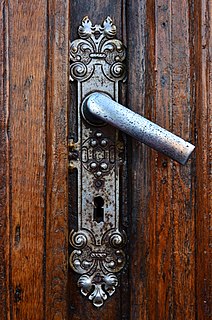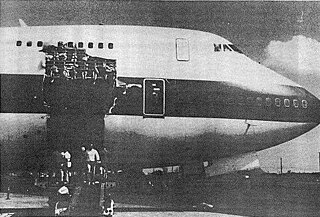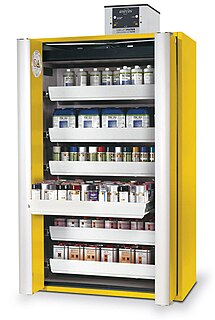
Gun safety is the study and practice of using, transporting, storing and disposing of firearms and ammunition, including the training of gun users, the design of weapons, and formal and informal regulation of gun production, distribution, and usage, for the purpose of avoiding unintentional injury, illness, or death. This includes mishaps like accidental discharge, negligent discharge, and firearm malfunctions, as well as secondary risks like hearing loss, lead poisoning from bullets, and pollution from other hazardous materials in propellants and cartridges. There were 47,000 unintentional firearm deaths worldwide in 2013.

Turkish Airlines Flight 981 was a scheduled flight from Istanbul Yeşilköy Airport to London Heathrow Airport, with an intermediate stop at Orly Airport in Paris. On 3 March 1974, the McDonnell Douglas DC-10 operating the flight crashed into the Ermenonville Forest, outside Paris, killing all 346 people on board. The crash was also known as the Ermenonville air disaster. Flight 981 was the deadliest plane crash in aviation history until 27 March 1977, when 583 people perished in the collision of two Boeing 747s in Tenerife. It remained the deadliest single-aircraft accident until the crash of Japan Airlines Flight 123 on 12 August 1985, and the deadliest aviation accident without survivors until the Charkhi Dadri mid-air collision on 12 November 1996. It remains the deadliest single-aircraft accident without survivors, the first fatal and deadliest crash involving the McDonnell Douglas DC-10, and the deadliest aviation accident to occur in France. It is also the deadliest aviation accident that did not involve a Boeing 747.

A crash bar is a type of door opening mechanism which allows users to open a door by pushing a bar. While originally conceived as a way to prevent crowd crushing in an emergency, crash bars are now used as the primary door opening mechanism in many commercial buildings.

A filing cabinet is a piece of office furniture for storing paper documents in file folders. In the most simple context, it is an enclosure for drawers in which items are stored. The two most common forms of filing cabinets are vertical files and lateral files. A vertical file cabinet has drawers that extend from the short side of the cabinet. A lateral file cabinet has drawers that extend from the long side of the cabinet. These are also called side filers in Great Britain. There are also shelf files, which go on shelves. In the United States, file cabinets are usually built to accommodate 8.5 × 11 paper, and in other countries, filing cabinets are often designed to hold other sizes of paper, such as A4 paper.

Door furniture or door hardware refers to any of the items that are attached to a door or a drawer to enhance its functionality or appearance.

A door handle or doorknob is a handle used to open or close a door. Door handles can be found on all types of doors including exterior doors of residential and commercial buildings, internal doors, cupboard doors and vehicle doors. There are many designs of door handle, depending on the appropriate use. A large number of handles, particularly for commercial and residential doors, incorporate latching or locking mechanisms or are manufactured to fit to standardised door locking or latching mechanisms.

American Airlines Flight 96 was a regular domestic flight operated by American Airlines from Los Angeles to New York via Detroit and Buffalo. On June 12, 1972, the left rear cargo door of the McDonnell Douglas DC-10-10 operating the flight blew open and broke off en route between Detroit and Buffalo above Windsor, Ontario; the accident is thus sometimes referred to as the Windsor incident, although for the NTSB it is an accident, therefore not an incident.

United Airlines Flight 811 was a regularly scheduled airline flight from Los Angeles to Sydney, with intermediate stops at Honolulu and Auckland. On February 24, 1989, the Boeing 747-122 serving the flight experienced a cargo-door failure in flight shortly after leaving Honolulu. The resulting explosive decompression blew out several rows of seats, resulting in the deaths of nine passengers. The aircraft returned to Honolulu, where it landed without further loss of life.

The trunk or boot of a car is the vehicle's main storage or cargo compartment, often a hatch at the rear of the vehicle. It is also called a tailgate.

A latch or catch is a type of mechanical fastener that joins two objects or surfaces while allowing for their regular separation. A latch typically engages another piece of hardware on the other mounting surface. Depending upon the type and design of the latch, this engaged bit of hardware may be known as a keeper or strike.

Childproofing is the act of making an environment or object safe for children. This reduces risks to a level considered acceptable by a society, an institution, or to specific parents. Childproofing may include restriction of children to safe areas or preventing children from reaching unsafe areas. This can be accomplished by the parent or by hiring a professional for assistance. Childproofing is gaining more prominence now that parents have greater access to information on child injury and a wide variety of products are available to help prevent it. It has become so top-of-mind for parents that even hotels and child-friendly resorts are offering "child-proof" rooms.

An electronic lock is a locking device which operates by means of electric current. Electric locks are sometimes stand-alone with an electronic control assembly mounted directly to the lock. Electric locks may be connected to an access control system, the advantages of which include: key control, where keys can be added and removed without re-keying the lock cylinder; fine access control, where time and place are factors; and transaction logging, where activity is recorded. Electronic locks can also be remotely monitored and controlled, both to lock and to unlock.

An electric strike is an access control device used for door frames. It replaces the fixed strike faceplate often used with a latch. Like a fixed strike plate, it normally presents a ramped or beveled surface to the locking latch allowing the door to close and latch just like a fixed strike would. However, an electric strike's ramped surface can, upon command, pivot out of the way when the lock on the door is in the locked position and the door is opened, allowing a user to pull/push the door to open it without operating the mechanical lock or using a mechanical key. After the door is opened past the keeper, the keeper returns to its standard position and re-locks when power is removed or applied, depending upon the strike's configuration.

Ground support equipment (GSE) is the support equipment found at an airport, usually on the apron, the servicing area by the terminal. This equipment is used to service the aircraft between flights. As the name suggests, ground support equipment is there to support the operations of aircraft whilst on the ground. The role of this equipment generally involves ground power operations, aircraft mobility, and cargo/passenger loading operations.
Hydraulic hooklift hoists are mounted on heavy duty trucks to enable hauliers to change out flatbeds, dumpster bodies, and similar containers. Primarily used in conjunction with tilt frame bodies and specialised containers, generally designed for the transportation of materials in the waste, recycling, scrap and demolition industries.

A car door is a type of door opening, typically hinged on its front edge, but sometimes attached by other mechanisms such as tracks, for entering and exiting a vehicle. Doors most often integrate side windows for visibility from inside the car and can be locked to secure the vehicle.

A gun safe is a safe designed for storing one or more firearms and/or ammunitions. Gun safes are primarily used to prevent access by unauthorized or unqualified persons for burglary protection and, in more capable safes, to protect the contents from damage by flood, fire, or other natural disasters. Access prevention is required by law in many places, necessitating a gun lock, metal gun cabinet, or gun safe. Gun safes have largely replaced the gun cabinets made of fine stained wood with etched glass fronts used for display that were commonly used decades ago, although some gun safes are made to resemble such gun cabinets.

A locker is a small, usually narrow storage compartment. They are commonly found in dedicated cabinets, very often in large numbers, in various public places such as locker rooms, workplaces, middle and high schools, transport hubs and the like. They vary in size, purpose, construction, and security.

Three-point locking, or a multipoint lock, is a locking system installed in cabinet or locker doors to enable more secure locking. Whereas in single-point locking, the door on a cabinet locks only at the point where the key is turned, halfway up the edge of the door, three-point locking enables the top and bottom of the door to be simultaneously secured. This is accomplished by attaching two long steel rods to the lock on the inside of the door, which extend vertically upwards and downwards: when the lock is turned, the rotary movement of the latch on the inside of the door translates to vertical movement in these rods, with the result that the upper rod moves upwards by an inch or so, and the lower rod moves downwards similarly. This causes the ends of the rods to move through small holes in the flanges at the top and bottom of the door, resulting from the metal of the door being turned inwards, and the rods then move a short distance into holes in the metal surrounding the door. This effectively immobilizes the top and bottom of the door, and greatly increases the security of the door-locking compared to a door with only single-point locking.

A safety cabinet is used for the safe storage of flammable chemical substance or compressed gas cylinders.



















